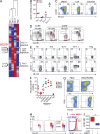Pro-inflammatory human Th17 cells selectively express P-glycoprotein and are refractory to glucocorticoids
- PMID: 24395888
- PMCID: PMC3892977
- DOI: 10.1084/jem.20130301
Pro-inflammatory human Th17 cells selectively express P-glycoprotein and are refractory to glucocorticoids
Abstract
IL-17A-expressing CD4(+) T cells (Th17 cells) are generally regarded as key effectors of autoimmune inflammation. However, not all Th17 cells are pro-inflammatory. Pathogenic Th17 cells that induce autoimmunity in mice are distinguished from nonpathogenic Th17 cells by a unique transcriptional signature, including high Il23r expression, and these cells require Il23r for their inflammatory function. In contrast, defining features of human pro-inflammatory Th17 cells are unknown. We show that pro-inflammatory human Th17 cells are restricted to a subset of CCR6(+)CXCR3(hi)CCR4(lo)CCR10(-)CD161(+) cells that transiently express c-Kit and stably express P-glycoprotein (P-gp)/multi-drug resistance type 1 (MDR1). In contrast to MDR1(-) Th1 or Th17 cells, MDR1(+) Th17 cells produce both Th17 (IL-17A, IL-17F, and IL-22) and Th1 (IFN-γ) cytokines upon TCR stimulation and do not express IL-10 or other anti-inflammatory molecules. These cells also display a transcriptional signature akin to pathogenic mouse Th17 cells and show heightened functional responses to IL-23 stimulation. In vivo, MDR1(+) Th17 cells are enriched and activated in the gut of Crohn's disease patients. Furthermore, MDR1(+) Th17 cells are refractory to several glucocorticoids used to treat clinical autoimmune disease. Thus, MDR1(+) Th17 cells may be important mediators of chronic inflammation, particularly in clinical settings of steroid resistant inflammatory disease.
Figures





Comment in
-
T cells: Spotting the troublemakers.Nat Rev Immunol. 2014 Feb;14(2):64-5. doi: 10.1038/nri3610. Nat Rev Immunol. 2014. PMID: 24457476 No abstract available.
-
Immunological disorders: Spotting the troublemakers.Nat Rev Drug Discov. 2014 Feb;13(2):103. doi: 10.1038/nrd4251. Nat Rev Drug Discov. 2014. PMID: 24481305 No abstract available.
References
-
- Afzali B., Mitchell P.J., Edozie F.C., Povoleri G.A., Dowson S.E., Demandt L., Walter G., Canavan J.B., Scotta C., Menon B., et al. 2013. CD161 expression characterizes a subpopulation of human regulatory T cells that produces IL-17 in a STAT3-dependent manner. Eur. J. Immunol. 43:2043–2054 10.1002/eji.201243296 - DOI - PMC - PubMed
Publication types
MeSH terms
Substances
Grants and funding
LinkOut - more resources
Full Text Sources
Other Literature Sources
Medical
Molecular Biology Databases
Research Materials

